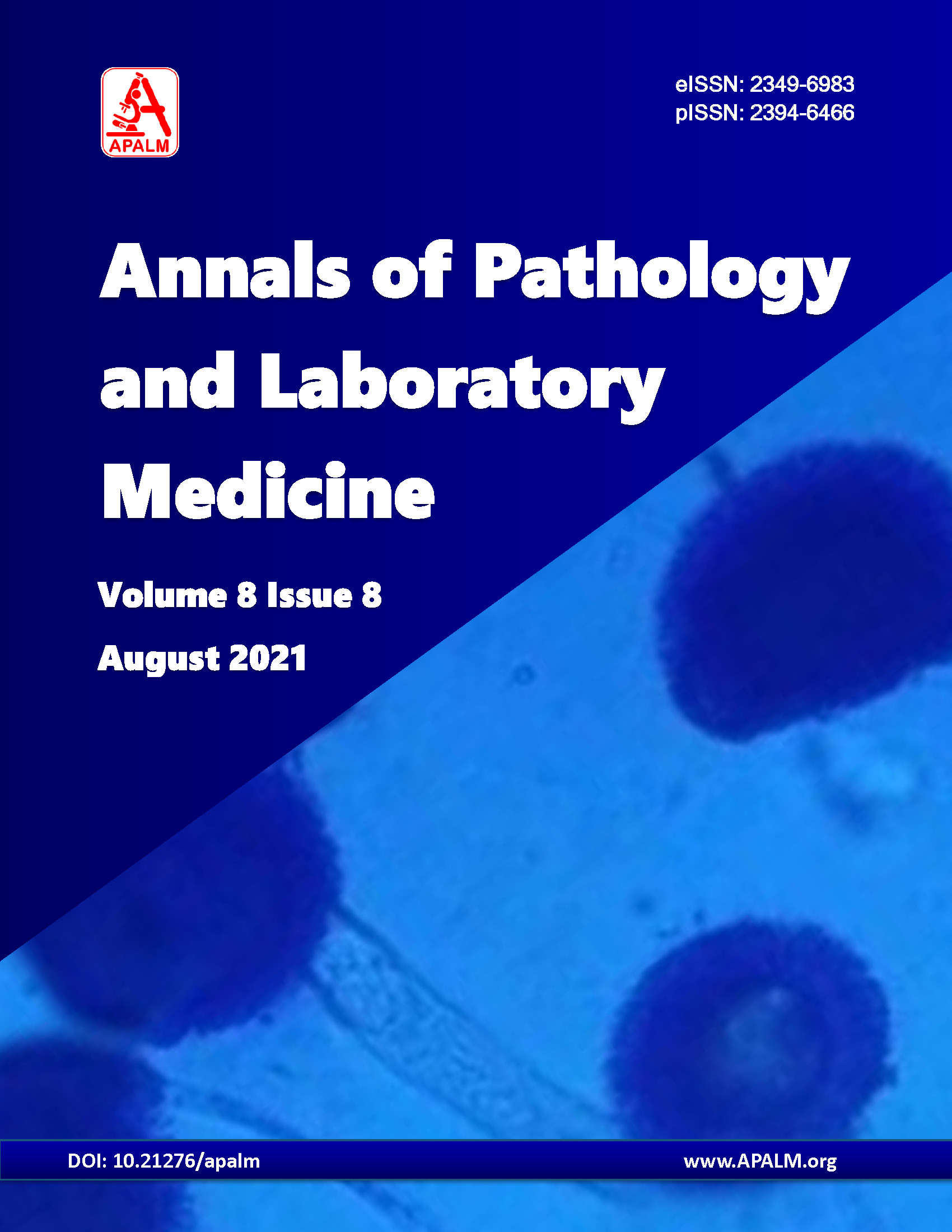Assessment of Utility of Fine Needle Aspiration Cytology in Patients of Peripheral Lymphadenopathy- Experience of A Tertiary Care Hospital
DOI:
https://doi.org/10.21276/apalm.3113Keywords:
Fine needle aspiration cytology, lymphadenopathy, granuloma, metastasis, lymphomaAbstract
Background: Fine needle aspiration cytology (FNAC) is a quick, sensitive, safe, reliable and cost-effective outdoor procedure that has a lower risk of complications as compared to a surgical biopsy. This study was conducted to analyse the various cytomorphological patterns establishing the diagnosis on FNAC in peripheral lymphadenopathy patients along with their clinical presentation.
Methods: This study included 300 patients of peripheral lymphadenopathy in a tertiary care hospital of north-central Haryana. FNAC was done under all aseptic conditions and various cytomorphological patterns were analysed.
Result: On stratification of lymph node lesions, 240/300 cases (80%) were reported as non-neoplastic and 60/300 cases (20%) as neoplastic lesions. Among the non-neoplastic lesions, granulomatous pathology was the commonest lesion encountered in 137/240 cases (57.1%), followed by reactive lymphoid hyperplasia and suppurative lymphadenitis. Metastatic involvement of lymph node was the commonest pathological finding diagnosed in 52/60 of malignant neoplastic cases (86.66%). Overall, the cervical lymph nodes were most commonly involved in 68.66% patients, followed by other lymph nodes.
Conclusion: Lymphadenopathy can have varied etiologies ranging from non-neoplastic to neoplastic conditions. FNAC as a first line investigative procedure in lymphadenopathy patients obviates the need for surgical excision and guides subsequent patient therapy and management. The cervical group of lymph nodes are most commonly involved in both non neoplastic as well as neoplastic lymph node lesions. In younger age group (<30 years) non neoplastic causes of lymphadenopathy are more common whereas in elderly the malignant neoplastic causes are more common. The secondary metastatic carcinoma is more common than primary lymphoma of the lymph nodes.
References
Rakhshan M. The diagnostic accuracy of fine needle aspiration cytology in neck lymphoid masses. Iranian J of Pathol 2009; 4: 147-150.
Narang RK, Pradhan S. Place of fine needle aspiration cytology in the diagnosis of lymphadenopathy. Ind J Tub 1990; 37: 29-32.
Guthrie CG. Gland puncture as a diagnostic measure. Bull Johns Hopkins Hosp 1921; 32: 266-268.
Kollur SM, El Hag IB. Fine needle aspiration cytology of metastatic nasopharyngeal carcinoma in cervical lymph nodes: comparison with metastatic squamous cell carcinoma and Hodgkin’ and Non-Hodgkin’ lymphoma. Diagn Cytopathol 2003; 28:18–22.
Al-Mulhim AS, Hafez NH, Tahoun NS, Reliability of fine needle aspiration cytology (FNAC)as a diagnostic tool in cases of cervical lymphadenopathy, Journal of the Egyptian National Cancer Institute 2011; 23(3), 105–114.
Mohanty R, Wilkinson A, Utility of Fine Needle Aspiration Cytology of Lymph nodes IOSR J of Dental and Med Sciences (IOSR-JDMS) 2013;8(1):13-18.
Hirachand S, Lakhey M, Akhter J, Thapa B. Evaluation of fine needle aspiration cytology of lymph nodes in Kathmandu Medical College, Teaching hospital. Kathmandu Univ Med J 2009; 7 (26):139–42.
Skoog L, Tani E. Lymph nodes. In: Gray W, Kocjan G ed¬itors. Diagnostic Cytopathology. Third edition. Edinburg: Churchill Livingstone 2010; 409-44.
Pandit AA, Candes FP, Khubchandani SR. Fine needle aspiration cytology of lymph nodes. Journal of Postgraduate Medicine, 1987; 33: 134-6.
Gray W, Kocjan G. Diagnostic Cytopathology. Third edition. Edinburg: Churchill Livingstone 2010; 409-44.
Koss LG (editor). Diagnostic cytology and its Histopathologic basis. Philadelphia: J B Lippincott; 1992.
Gorle VK, Inamdar P. A clinicopathological study on cervical lymphadenopathy: an institutional experience. Int Surg J 2018; 5(8): 2841-2845.
Paikrao YM, Deshpande PM, Chintale KN. Clinicopathological study of cervical lymphadenopathy at rural tertiary health care centre. Int J Adv Med 2018; 5(1): 154-58
Gojiya P, Goswami A, Shah S. Evaluation of fine needle aspiration cytology of cervical lymphadenopathies at tertiary care center. APLAM 2018; 5(1): A22-A27
Anila KR, Nayak N, George PS, Jayasree K. Utility of fine needle aspiration cytology in evaluation of lymphadenopathy- an audit from cancer centre in south India. GJO 2015; 50-57
Malhotra AS, Lahori M, Nigam A, Khajuria A: Profile of lymphadenopathy: an institutional based cytomorphological study. Int J Appl Basic Med Res. 2017, 7:100-103
Bottles K, McPhaul LW, Volberding P. Fine needle aspiration biopsy of patients with the acquired immuno deficiency syndrome (AIDS). Experience in an outpatient clinic. Annal of Internal Medicine 1988; 108:42-5.
Hirachand S, Lakhey M, Akhter J, Thapa B. Evaluation of fine needle aspiration cytology of lymph nodes in Kathmandu Medical College, Teaching hospital. Kathmandu University Medical Journal. 2009; 7:139-42.
Khajuria R, Goswami KC, Singh K, Dubey VK. Pattern of Lymphadenopathy on Fine Needle Aspiration Cytology in Jammu. JK science. 2006; 8:23-8.
Kumuguru, M.H.Kulkarni, N.S.Kamakeri. FNAC of peripheral lymph nodes in HIV- positive patients.Scentific Medicine. 2009;1:1-7
Downloads
Published
Issue
Section
License
Copyright (c) 2021 Upender Sharma, Ajit Singh, Hemlata T Kamra, Atul Beniwal, Sonam Sharma

This work is licensed under a Creative Commons Attribution 4.0 International License.
Authors who publish with this journal agree to the following terms:
- Authors retain copyright and grant the journal right of first publication with the work simultaneously licensed under a Creative Commons Attribution License that allows others to share the work with an acknowledgement of the work's authorship and initial publication in this journal.
- Authors are able to enter into separate, additional contractual arrangements for the non-exclusive distribution of the journal's published version of the work (e.g., post it to an institutional repository or publish it in a book), with an acknowledgement of its initial publication in this journal.
- Authors are permitted and encouraged to post their work online (e.g., in institutional repositories or on their website) prior to and during the submission process, as it can lead to productive exchanges, as well as earlier and greater citation of published work (See The Effect of Open Access at http://opcit.eprints.org/oacitation-biblio.html).










